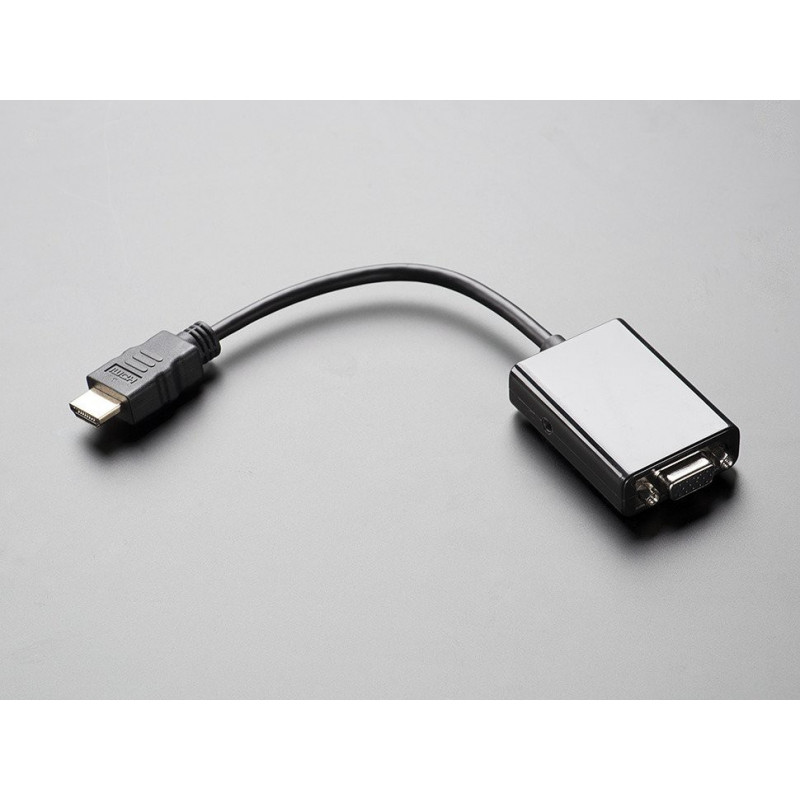

location_on 4131 Fraser St. Vancouver BC Get Directions
phone 604-875-1993 Call us
access_time Hours
| Monday - Friday | 9AM - 5:30PM |
| Saturday - Sunday & Holidays | Closed | See Holiday Hours |



If you have a computer or tablet or device with HDMI output but you want to connect it to a projector, monitor or display with VGA input, you have come to the right place! This nifty adapter cable has a classic HDMI plug connector at one end and at the other end a DB-15 VGA connector (it has hex nuts that you can remove if you are trying to mate it with a cable that also has hex nuts). There's also an audio jack on the side, this provides stereo headphone/line out (HDMI 1.3 cables carry both video and audio). You may also need a VGA DB15 male/male cable (not included but available in the shop) to connect this to your monitor.
We tried this out with a Raspberry Pi and an old VGA monitor we had and found the display output to be very crisp and vivid. The video works fantastic with a Raspberry Pi right out of the box. To enable the audio and customize the resolution, check the Technical tab for our suggested /boot/config.txt The easiest way to do that is to insert the programmed Pi SD card into your computer and look for the config.txt file that is in the root directory of the SD card, edit it, and save it. The monitor will look best if you can set the HDMI output to the matching resolution so try that if you want a good looking display.
It also works with other kinds of computers and HDMI output devices, we plugged it into a an XBOX360 and then also a Windows box and it came up as a secondary monitor with adjustable resolutions (from 800x600 up to 1920x1080) in the Display panel.
Package comes with one HDMI to VGA adapter.
Here's our known-good /boot/config.txt which will set the resolution to 800x600 and enable the audio out of the adapter. we have a couple other resolution options documented as well!
# uncomment if you get no picture on HDMI for a default "safe" mode #hdmi_safe=1 # uncomment this if your display has a black border of unused pixels visible # and your display can output without overscan #disable_overscan=1 # uncomment the following to adjust overscan. Use positive numbers if console # goes off screen, and negative if there is too much border #overscan_left=16 #overscan_right=16 #overscan_top=16 #overscan_bottom=16 # uncomment to force a console size. By default it will be display's size minus # overscan. #framebuffer_width=1280 #framebuffer_height=720 # uncomment if hdmi display is not detected and composite is being output #hdmi_force_hotplug=1 # uncomment to force a specific HDMI mode (this will force VGA) hdmi_group=2 hdmi_mode=87 # Put your VGA monitor resolution below # hdmi_cvt = # width width in pixels # height height in pixels # framerate framerate in Hz # aspect aspect ratio 1=4:3, 2=14:9, 3=16:9, 4=5:4, 5=16:10, 6=15:9 # margins 0=margins disabled, 1=margins enabled # interlace 0=progressive, 1=interlaced # rb 0=normal, 1=reduced blanking # For example, 800x600 @ 60 Hz hdmi_cvt=800 600 60 1 0 0 1 # or maybe 800x480 @ 60 Hz #hdmi_cvt=800 480 60 6 0 0 1 # or, 1024 x 768 @ 50 Hz #hdmi_cvt=1024 768 60 1 0 0 1 # or if you're not sure, nothing beats 640x480 #hdmi_cvt=640 460 60 1 0 0 1 # see http://www.raspberrypi.org/forum/viewtopic.php?f=29&t=24679 # uncomment to force a HDMI mode rather than DVI. This can make audio work in # DMT (computer monitor) modes ############################################################### ### THIS LINE IS WHAT ENABLES THE AUDIO OUT OF THE ADAPTER! ### hdmi_drive=2 ############################################################### # uncomment to increase signal to HDMI, if you have interference, blanking, or # no display #config_hdmi_boost=4 # uncomment for composite PAL #sdtv_mode=2 #uncomment to overclock the arm. 700 MHz is the default. #arm_freq=800 # for more options see http://elinux.org/RPi_config.txt
